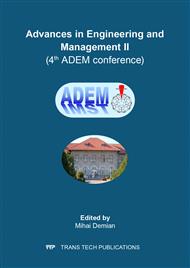[1]
J.H. Bernstein, Transdisciplinarity: A Review of Its Origins, Development, and Current Issues, Journal of Research Practice, Volume 11, Issue 1, Article R1, 2015. Available at http://jrp.icaap.org/index.php/jrp/article/view/510/412.
Google Scholar
[2]
B. Nicolescu, Methodology of transdisciplinarity – levels of reality, logic of the included middle and complexity, Transdisciplinary Journal of Engineering & Science Vol: 1, No:1, December, 2010, pp.19-38.
DOI: 10.22545/2010/0009
Google Scholar
[3]
A. Drews, A. Sagawe, Dialogue Maps: Supporting interactive, transdisciplinary dialogues with a web-based tool for multi-layer knowledge maps in: Information Technology in Environmental Engineering: Selected Contributions to the Sixth International Conference on Information Technologies in Environmental Engineering (ITEE2013), Springer Science & Business Media, 2013, pp.39-53.
DOI: 10.1007/978-3-642-36011-4_4
Google Scholar
[4]
G. Tejedor, J. Segalàs, Transdisciplinarity. Which role for sustainable development education and its situation within engineering education, Available at https://upcommons.upc.edu/bitstream/handle/2117/28400/Tejedor_G_et_al_EESD15_075_Transdisciplinarity.pdf.
Google Scholar
[5]
European Commission, Directive 2008/1/EC of the European Parliament and of the Council of 15 January 2008 concerning integrated pollution prevention and control.
Google Scholar
[6]
W. Mauser, G. Klepper, M. Rice, et. all., Transdisciplinary global change research: the co-creation of knowledge for sustainability, Current Opinion in Environmental Sustainability, 2013, 5:420–431, Available at http://www.sciencedirect.com/science/article/pii/S1877343513000808.
DOI: 10.1016/j.cosust.2013.07.001
Google Scholar
[7]
The National Action Plan in the Field of Energy from Renewable Sources (PNAER), Bucharest, 2010). Available at http://www.icemenerg.ro/PROSERV/PNAER.htm.
Google Scholar
[8]
Ministry of Agriculture and Rural Development in Romania, Renewable energy in agriculture, Bucharest, (2014).
Google Scholar
[9]
Information on http://www.ivm.vu.nl/ en / Organisation/ departments/ environmentaleconomics/ index.aspx.
Google Scholar
[10]
Information on http://mirceacomsa.wordpress.com/2015/06/30/reglementari-si-constrangeri-in-domeniul-energiei-electrice-produse-din-resurse-regenerabile.
Google Scholar


